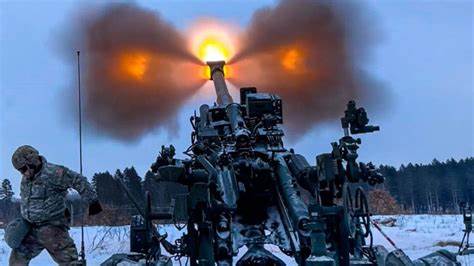Russia Set To Unleash Its ‘Most Lethal’ Artillery Against Ukraine

The Russian Ministry of Defense (RuMoD) announced on January 30 that the first batch of the newest 2S35 self-propelled artillery complex, also known as “Coalition-SV” or “Koalitsiya-SV,” is nearing completion of production. This development comes as ground combat in Ukraine continues to exacerbate the need for artillery warfare.
Russian Defense Minister Sergei Shoigu was in charge of the state defense order for the manufacture of new self-propelled artillery units in Yekaterinburg, according to RIA Novosti. In addition, he mentioned that compared to 2022, the amount of self-propelled artillery units produced has increased six times.
Sergei Shoigu visited the Ural Plant of Transport Engineering to oversee the execution of the state defense order for the manufacture and maintenance of the 2S19 “Msta-S,” 2S3 “Acacia,” 2S4 “Tulip,” 2C5 “Hyacinth,” and 2C35 “Coalition SV” self-propelled artillery systems.
The Minister also criticized the company’s chief designer for delaying the production of an extremely promising artillery complex without mentioning any specific system.
“We tackled this head-on in 2022. By 2023, we ought to have all of these machines operational, and you seem so at ease, which is good,” Shoigu remarked.
The Coalition SV self-propelled artillery complex, which is thought to be the most deadly artillery system Russia has ever developed, is said to have started serial production in December of last year. It’s been widely reported that this weapon system possesses unique capabilities that have the potential to significantly alter the battlefield environment. It is unclear, though, if the system was tested in Russia’s alleged “special military operation” zone.
The Coalition-SV, a vehicle with a range of 70–80 kilometers, is expected to be deployed on the front lines this year. With its amazing firing rate of over ten, possibly sixteen, rounds per minute, the artillery complex sets a new benchmark for self-propelled howitzers, according to military analysts.
The system is highly automated, and because of features like an automated system that manages target selection, gun aiming, and navigation, it is commonly referred to as a “combat robot,” according to Bekhan Ozdoev, industrial director of Rostec’s Armaments, Ammunition, and Special Chemicals Cluster.
Despite having more in common with a T-14 Armata tank in terms of hull and crew, the Coalition-SV guns are mounted on a T-90 chassis. Equipped with a contemporary 2A88 cannon that fires 152mm artillery shells, the self-propelled system is ready for combat.
By using guided artillery shells, the complex is intended to destroy air defense, missile defense, armored vehicles, command posts, communication centers, artillery and mortar batteries, and more. Drones provide guided shells with laser identification.
According to reports, the 2S19 Msta-S will be replaced by the Coalition-SV. The single-barrel system has been a work in progress, but it holds great promise as a cutting-edge weapon. As of April 2023, for example, the self-propelled cannon was still undergoing state trials; however, these were completed in October, paving the way for mass production.
In addition, a vehicle with eight by eight wheels is being tested on a KAMAZ truck chassis to meet the requirements of contemporary warfare and urban warfare, as demonstrated in Ukraine.
Wheeled self-propelled guns are more mobile than conventional tracked ones in a well-developed road network, but they can still travel long distances on regular highways without causing damage to the pavement.
“I think they will appear there [on the battlefield in Ukraine] soon since howitzers of this class are needed to provide an advantage over Western artillery models in terms of firing range,” stated Sergei Chemezov, the head of the state defense conglomerate Rostec, late last year. Despite earlier Russian media reports indicating that at least one of these was deployed in Ukraine for state trials, no confirmed reports have confirmed the complex’s use in that country.
Russia Is Pacing Ahead In The Artillery Race
The most recent information regarding the Coalition-SV is being released at a time when fighting between the two groups is escalating once more. The government’s push for the development and deployment of this weapon system further suggests that Russia continues to largely depend on artillery support in its conflict with Ukraine.
Likewise, Kyiv’s forces have been relentlessly hitting Russian positions with Howitzers and HIMARS that they received from the West. Russia’s artillery warfare edge has been subtly blunted by the HIMARS, which has destroyed its forward-deployed howitzers, including the 2S19 Msta-S. The Russians, though, appear to have adapted to it.
Although Russia has had difficulties in other areas of the war, its artillery has been crucial to its ability to repel Ukrainian forces. Russia’s primary weapon of choice in close-quarters combat is artillery. Its combined weapons components have been tasked with arranging themselves so that the artillery can deal tremendous damage to their adversaries, as the think tank RUSI has pointed out in a detailed report.
In light of this, military analysts have noted that Ukrainian troops will need additional armament to try to lessen the enemy’s firing edge because they are unable to keep up with Russia’s current rate of artillery fire. This proposal is made in the context of Kyiv’s deteriorating military outlook.
The Foreign Policy Research Institute’s Rob Lee, the Carnegie Endowment for International Peace’s Michael Kofman and Dara Massicot, and other analysts recently concluded that “Western-provided artillery ammunition in the future is unlikely to support a fire rate that exceeds Russia’s.”
There is a severe shortage of ammunition in Kyiv, and the Russian military outguns the Ukrainian military. Furthermore, it is not good news for Ukraine that Russia is allegedly in possession of weapons made in North Korea and has increased production of its modern systems and shells.
Russia is reportedly approaching daily totals of roughly 10,000 shells, whereas the Ukrainians are currently only putting out 2,000 artillery rounds. According to the experts, Moscow’s fire rate will be “more than that number” the following year.
“Since Ukraine was unable to overcome Russia’s defenses last summer with a quantitative advantage with artillery ammunition, the prospects for future offensives will be worse unless Ukraine and its supporters can compensate by developing other advantages,” Kofman, Massicot, and Lee stated in their article.
“This implies that the volume of artillery fire will have to be supplemented with drones and other precision strike capabilities in the future,” the experts continued.
That being said, NATO last week signed a $1.2-billion agreement to manufacture tens of thousands of artillery rounds in order to replenish member countries’ rapidly emptying ammunition stocks and arm Ukraine in order to thwart Russia’s incursion.
The deal would make it possible to obtain 220,000 rounds of 155-millimeter ammunition, the most sought-after artillery shell, according to NATO’s support and procurement office.
It will make it possible for allies to increase their military supplies and give Ukraine more weapons, such as longer-range missiles, more precision-guided ammunition, and other cutting-edge and increased military support to lessen the military advantage that the Russians currently possess.








